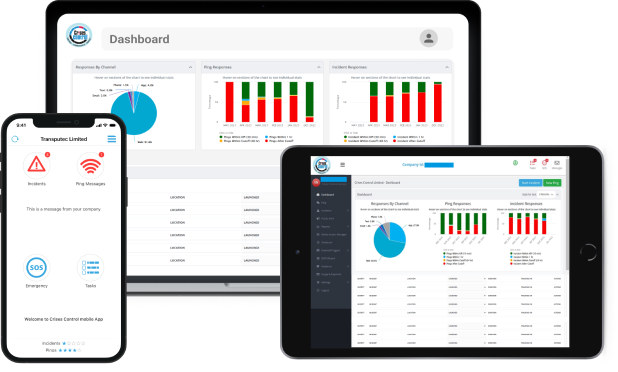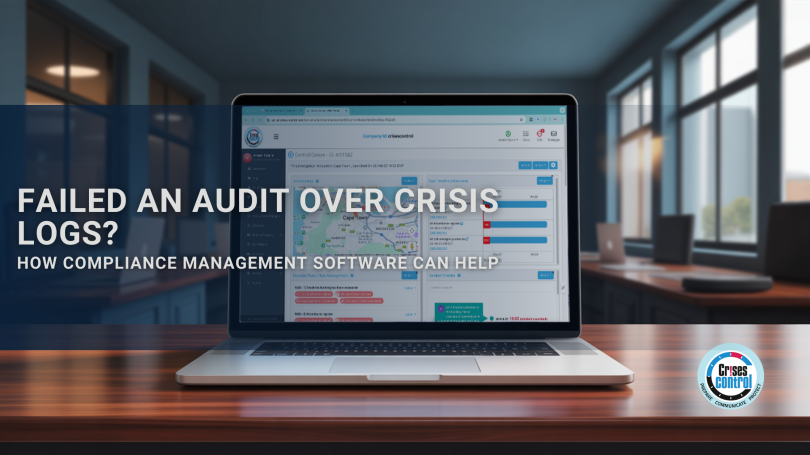Written by Anneri Fourie | Crises Control Executive
You handled the crisis. You kept the business running. The team pulled together under pressure. Then the audit came, and you failed. Not because of what you did, but because you couldn’t prove it.
You’re not alone. For many companies, audit failures don’t happen due to bad decisions during a crisis, but because of poor documentation. Crisis logs are missing, scattered, inconsistent, or they were never captured properly in the first place. And when auditors can’t see what happened, they assume it didn’t happen at all.
That’s where compliance management software comes in. It takes the stress and guesswork out of crisis documentation and helps ensure that every incident is logged, every decision is recorded, and every audit can be passed with confidence. In this blog, we’ll break down why crisis logs are so often the weak link in audit compliance, and how a platform like Crises Control can make that problem go away.
Where Things Go Wrong: Why Crisis Logs Fail Audits
Let’s get straight to the point. Most companies don’t fail audits because they didn’t act correctly during a crisis. They fail because they didn’t record the right information at the right time. Here are the most common problems that come up during audits:
1. Logging Is Manual and Disconnected
You’ve got people making phone calls, sending emails, updating spreadsheets, each in their own way, often with no central record. Some decisions are made in chat threads, others on a call that wasn’t recorded. Auditors can’t follow a clear path. And frankly, neither can your team when looking back.
2. There’s No Single Source of Truth
Crisis response often involves multiple departments; IT, comms, HR, security. If each of them is keeping their own notes and there’s no centralised platform pulling it all together, then your crisis log ends up fragmented and full of gaps.
3. Logs Aren’t Consistent or Structured
Auditors want a full timeline: what happened, who responded, what decisions were made, and when. If logs are incomplete or vague (“sent message to team”), they’re unlikely to meet audit standards.
4. Nothing Was Logged in Real Time
When documentation happens after the fact, or not at all, it’s unreliable. People forget details. Timings get muddled. Real-time logging is crucial for showing auditors exactly what happened, without relying on memory or interpretation.
What Auditors Actually Want to See
To pass an audit, it’s not enough to say you responded correctly, you have to prove it. Here’s what most auditors look for when reviewing how your organisation handled an incident:
- A clear timeline of actions, with timestamps
- Names or roles of people who triggered, acknowledged, and responded to alerts
- Records of communications, including who received and confirmed them
- Classification of incidents; severity, type, and whether they were escalated
- Evidence of internal approvals, if decisions were escalated
- A full post-incident report showing how the situation was managed
If even one of these elements is missing or unclear, you could be at risk of non-compliance.
How Compliance Management Software Solves the Problem
Let’s be clear, this is not about adding more admin work to a crisis response. In fact, the right compliance management software does the opposite. It automates the capture of your actions and decisions as they happen, without slowing anyone down.
Here’s how a tool like Crises Control solves the problem and sets you up for audit success:
Automate Real-Time Logging Without the Manual Work
Every action taken during a crisis, sending an alert, acknowledging a message, escalating a decision, is automatically captured, timestamped, and logged in real time. That means you don’t have to rely on someone remembering to write it down later. The log builds itself as the incident unfolds.
So when the audit comes? You have a minute-by-minute account ready to go.
Keep All Your Business Continuity Logs in One Place
Instead of scattered emails, spreadsheets, or handwritten notes, Crises Control gives you a central platform where all communication and decisions are recorded and stored securely. Everything’s in one place. You don’t have to search or piece it together. It’s just there, complete and accessible.
This centralisation is also vital when different teams are involved. Whether it’s IT reporting a system failure or HR responding to a people-related issue, the full picture is available to everyone who needs it.
Use Incident Templates to Keep Responses Consistent
During a high-pressure incident, people don’t always follow the same process. That’s understandable, but it’s risky when it comes to compliance. Crises Control lets you create pre-configured incident templates, with clear steps, escalation paths, and communication flows built in.
That means no one has to guess. Everyone follows the same playbook, which keeps your documentation clear and consistent, exactly what auditors want to see.
Generate Audit-Ready Reports in Minutes
When you need to show what happened, Crises Control makes it easy. With just a few clicks, you can generate a full report of the incident: when it was raised, how it was handled, who did what, and what the outcome was.
These reports are structured, searchable, and exportable, perfect for auditors, regulators, or internal reviews.
Improve Accountability Without Micromanagement
Every interaction in Crises Control is linked to a user or team. So when someone sends an alert, acknowledges a message, or updates a status, it’s automatically logged with their name and the exact time.
This helps build trust and accountability, not just for audits, but for post-incident reviews, training, and improving your processes in the future.
A Real Example: Turning Audit Failure Into Compliance Strength
One of our clients, a multinational logistics company, came to us after failing an internal audit. Their issue wasn’t a poor response, it was that no one could prove what had been done, when, or by whom. Their crisis logs were stored in different formats, across different teams, and much of the communication had happened verbally or via untracked chat.
After implementing Crises Control:
- All incidents were logged in real time, automatically
- Every decision and action was tracked with timestamps
- Teams used consistent templates for incident handling
- Reports could be generated instantly for compliance review
At their next audit, not only did they pass, but they were specifically praised for the clarity and structure of their documentation. More importantly, they no longer had to scramble to “prepare” for audits. The data was already there, ready whenever they needed it.
The Cost of Getting This Wrong
Let’s be honest. Failing an audit doesn’t just mean red ink on a report. It can lead to:
- Financial penalties or regulatory fines
- Loss of certifications (like ISO 22301)
- Damage to reputation and client trust
- Disruption to operations while issues are corrected
And worst of all, it can give a false impression of how your team performs under pressure. You might have managed the crisis brilliantly, but if you can’t show it, it counts for nothing.
The cost of not investing in proper compliance management can be far higher than the cost of getting it right.
Ready to Pass Your Next Audit with Confidence?
Audit readiness isn’t about reacting when the inspector shows up. It’s about having everything in place before they even ask.
Crises Control gives you the tools to capture every action, manage every incident, and report on every response, clearly, quickly, and with complete confidence.
Make audits one less thing to worry about
Contact us now to book your free demo and see how Crises Control can help you avoid audit failures, strengthen compliance, and stay fully in control, no matter what comes your way.
Request a FREE Demo

